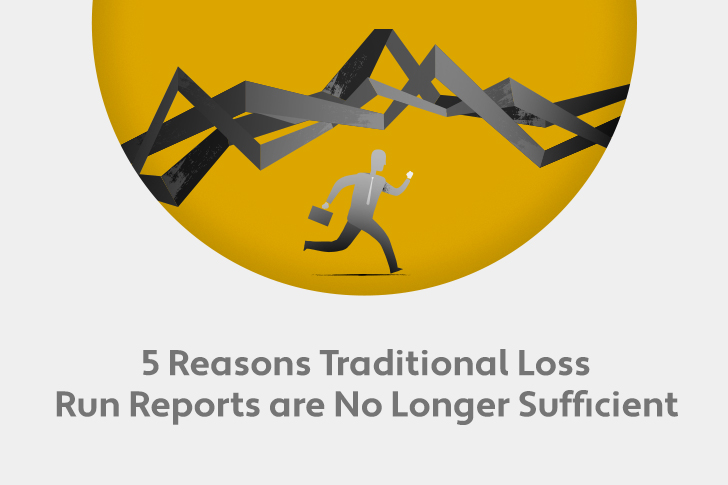Loss-run reports summarize all claims incurred by a business within a specified period. They help identify patterns and trends and monitor claims-handling practices to ensure that they are consistent with industry standards. These reports typically include information such as the date of the claim, the type of claim, the amount paid out, and the claim’s status.
Insurance companies and policyholders use a loss-run report to track claims and assess the overall performance of their insurance program. They can also identify trends, patterns, and potential areas of improvement in claims management.
Traditional Vs. Modern Loss Run Reports
Traditional loss run reports are typically generated using the claims data reported to the insurance company. The process of creating a conventional loss run report typically includes the following steps:
Data collection
The insurance company collects claims data from various sources, such as policyholder reports, medical providers, and third-party administrators.
Data entry
The claims data is entered into the insurance company’s claims management system or a separate loss-run report system.
Data validation
The claims data is validated to ensure that it is complete and accurate. This may include checking for missing information or inconsistencies in the data.
Data sorting and summarizing
The claims data is sorted and summarized to create the loss run report. This may include grouping claims by type, date, or other criteria.
Report generation
The loss run report is generated in a format that can be easily understood and analyzed. This may include tables, charts, or other visual elements.
Distribution
The loss run report is distributed to the policyholder or third party who submitted a report request in electronic or paper form.
It is important to note that traditional loss run reports are based on claims data reported to the insurance company. The data may only be complete or accurate sometimes. And they cannot efficiently analyze the data to identify trends, patterns, and potential areas of improvement.
Reasons Why Traditional Insurance Loss Runs May No Longer Be Sufficient
Increased Complexity Of Claims
Claims are becoming more complex due to technological advancements, cyber risks, and increased natural disasters. This complexity makes it difficult for traditional loss runs to capture all the necessary information.
Lack Of Real-Time Data
Traditional loss runs are based on data reported after the fact, making it difficult to promptly identify and respond to emerging risks.
Limited Ability To Analyze Data
Traditional loss runs provide a snapshot of claims data. But they cannot analyze the data using modern data analysis tools. Any analysis will have to be carried out manually.
Limited Scope
Traditional loss runs typically focus on a specific line of business, such as workers’ compensation, and do not provide a comprehensive view of an insurer’s overall risk profile.
Disadvantages Of Traditional Insurance Loss Run Reports
Inability To Identify Emerging Trends
Traditional loss-run reports cannot identify emerging trends, such as new types of claims or changes in claim frequencies. This requires modern tools and a large amount of data.
Inability To Forecast Future Losses
Traditional loss-run reports cannot forecast future losses, which makes it difficult for insurers to plan for and mitigate risks.
Inability To Identify Areas Of Improvement
Traditional loss-run reports cannot identify areas of improvement, such as claims handling processes or underwriting practices, that may contribute to higher loss ratios.
Steps To Obtain Better Loss Run Reports
Use Advanced Analytics
By using advanced analytics, such as predictive modeling and machine learning, you can analyze large amounts of data and identify trends, patterns, etc., that may not be visible in traditional loss runs.
Gather More Data
Gather more data from various sources, including social media, weather data, and other external sources. This can provide a complete picture of the claims and their risks.
Use Real-Time Data
Real-time data allows for more accurate and up-to-date risk forecasting because it provides a more current and comprehensive picture of the situation. This can be especially useful in volatile or rapidly changing situations, such as macroeconomic conditions or natural disasters.
Additionally, real-time data can help identify new or emerging risks that may not have been visible using historical data. It can lead to more efficient and effective risk management.
Integrations
Integrate loss runs with other data sources, such as financial data, to get a complete view of an insurer’s overall risk profile. Integrating multiple data sources can provide a more comprehensive and accurate picture of a situation because it allows for diverse perspectives and insights.
Each data source may provide a unique perspective on the situation, and combining these perspectives can lead to a complete understanding of the situation. Additionally, integrating multiple data sources can help identify patterns, trends, and relationships that may have yet to be visible using a single data source.
Use A Specialized Software
Utilise specialized software, such as loss run reporting software, to automate collecting, analyzing, and reporting loss run data. Also, these software applications can help to improve the accuracy and completeness of loss run reports.
Consult With Experts
Consult with experts in the field of insurance data analysis to help you understand the data and identify areas for improvement.
Modern Loss Run Reports
Modern loss-run reports in the digital age are typically generated using advanced analytics and technology. The process of creating a current loss run report typically includes the following steps:
Data Collection
Data is collected from various sources, including claims management systems, policyholder reports, and other external data sources. This additional data will allow insurance providers to create a more comprehensive loss run the report.
Data Integration
The data is integrated from various sources, cleaned, organized, and standardized. This provides a better view of the risk profile, allowing insurance providers to judge insurers better.
Data Analysis
Modern analytics methods such as predictive modeling and machine learning can help insurance providers forecast and manage risk better than manual methods could.
Report Generation
The loss run report is generated in a format that can be easily understood and analyzed. This may include tables, charts, or other visual elements. These reports may also include forecasting models.
Distribution
The loss run report is distributed to the policyholder or third-party requesting it electronically or on paper.
Conclusion
In summary, modern loss-run reports use technology and big data to generate more accurate and comprehensive reports. These reports are based on data from multiple sources, such as claims management systems, social media, and weather data, and use advanced analytics to identify trends, patterns, and potential areas of improvement. They are also more likely to be available in real time and can be distributed electronically.
Learn more about modern loss run reporting and explore how your company can benefit from outsourcing your insurance loss run processing services to a BPO provider.



